-

人教版新目标初中英语八年级下册It’s a nice day, isn’t it教案2篇
"Hello! Welcome to English class! Introduce yourself. Meet your new classmates." That's what the teacher says. What do you say? "Oh no!" It can be difficult talking to new people. But it can be fun, and you can make friends. How do you do it? Make small talk. Small talk is polite conversation. "Wang Nan is a great pingpang player, isn't she?" "I'd love to meet her, wouldn't you?" "It's been raining a lot, hasn't it?" Tag questions are a form of polite speech. To make small talk successfully, you should know how to make them. You should also know what topics to talk about. Try to learn this unit carefully. The next time you're in English class, you'll find out. Making small talk's easy, isn't it? (“你好!欢迎你!请做一下自我介绍。认识一下你的新同学。”通常在课上老师会这样说。你会说什么呢?“噢,不!”与陌生人谈话太困难了。但是这也很有意思,并且你还能交到朋友。你该怎么做呢?闲聊。闲聊指得是礼貌的对话。“王楠是一个很棒的乒乓球运动员,不是吗?”“我希望自己能认识她,你呢?“今年的雨水很多,不是吗?”反意疑问句是一种礼貌用语。为了使得谈话成功,你应该知道怎样去进行闲聊。你还应该知道与不同的人该谈论什么样的话题。认真的学习这个单元吧,下次在英语课上,你会发现与大家展开谈话是一件很容易的事情,不信我们来试试。)

人教版新目标初中英语八年级下册Would you mind turning down the music教案
Step 4. Group work (4)1. Ask a pair of students to read the dialogue. Say, This activity provides speaking, listening and writing practice using the target language.2. Ask students to complete the work in groups.3. Check the answers with the whole class. 4. Explain some of the language points. Step 5. Word review (Self check 1)1. Ask students to read the words and the phrases given. 2. Fill in the blanks with proper forms of these words to complete the sentences. 3. Check the answers with the whole class. Homework:Do activity 2 on page 57 after class. Period 6Teaching aims: 1. Teach vocabulary words and the useful expressions. 2. Enable the students to learn etiquette in different culture. 3. Help the students learn how to behave politely in public places and in daily life. Teaching procedures:Step 1. RevisionHelp students to review the function of making requests through a free talk. Then lead them to the topic of etiquette. Explain the meaning of etiquette. Or, ask students to look it up in the dictionary. Step 2. Pre-reading (Section 1)1. Ask students to read the picture and make a list with their partner about how many rules of etiquette can be seen being broken.

人教版新目标初中英语九年级下册By the time I got outside, the bus had already left教案
Ⅰ. Teaching Aims and Demands1. Knowledge Objects(1) Key Vocabularyoversleep(2) Target LanguageWhat happened?I overslept. And by the time I got up, my brother had already gotten in the shower.2. Ability Objects(1) Teach the students to use the new words.(2) Train the students to narrate past events with the Past Perfect Tense.(3) Train the students' listening and speaking skills with the target language.3. Moral ObjectIt’s a good habit to go to bed early in the evening and get up early in the morning. So you’ll never be in a hurry in the morning.Ⅱ. Teaching Key Points1. Key Vocabularyoversleep2. Target LanguageNarrate past events with the Past Perfect TenseⅢ. Teaching Difficult Points1. Train the students to narrate past events with the Past Perfect Tense.2. Train the students to understand the target language in spoken conversation.Ⅳ. Teaching Methods1. Thinking of examples from the students' real lives.2. Making sentences by looking at the pictures.Ⅴ. Teaching AidA tape recorderⅥ. Teaching ProceduresStep I Revision1. Revise the language points in Unit 8.Ask some questions like this: What volunteer work would you like to do?Help the students to answer, I’d like to…/I love to…/I hope to2. Practice the dialogue in Activity 3c on page 62 again. Get students to role play the similar dialogues with the following.

人教版新目标初中英语九年级下册Could you please tell me where the restrooms are教案
Step Ⅰ RevisionCheck homework. Ask a few students to read the article in 3a.Then ask a few students to read their guides.Step Ⅱ Part 1Look at the words in the box. Ask a student to read them. Make sure the students understand the meaning of the words. You are to fill in the blanks with the words. In some cases, students may need to use another form of the word, for example adjusting for tense or subject/ verb agreement.Ask students to fill in the blanks on their own.Check the answers. Step ⅢPart 2Go through the instructions with the class.Look at the example with the students.Ask students what the answer would be.Ask a student to read the question and answer it.Excuse me, could you tell me where the bank is, please?The bank is across the street from the shopping malt.Get students to complete the work in pairs.Check the answers. Ask a few students to read their questions.Step Ⅳ Just for Fun!Ask all the students to read the conversation. Ask: What is funny about this cartoon? Help students to explain. A Martian is a person from the planet Mars.There is no such thing as Martian food on Earth, and the clerk looks silly because he is trying to think of where there is a Martian restaurant.Invite some pairs of students to present this conversation to the rest of the class.Step Ⅴ Summary and HomeworkIn this class, we’ve done much writing practice using the key vocabulary words and the target language presented in this unit. After class, please finish the questions in 2 in your exercise books. Then finish the exercises on pages 47~48 of the workbook as well.The Seventh Period Ⅰ Teaching Aims and Demands1. Knowledge Objects(1) Key Vocabularyimage, adventure, jealousy, hero, crime, journey, brave, no longer, show interest in, take it easy, become interested in, plain looks(2)Text:Grown-ups like cartoons, too.2. Ability Objects(1) Fast-reading to get a general idea of the text.(2) Careful-reading to get the detailed information in the text.

人教版新目标初中英语九年级下册We’re trying to save the manatees教案2篇
本单元主要围绕着有关濒临灭绝的动物这一话题,学习了应该怎样保护我们的环境,以及就某一问题展开辩论。目标提示语言目标能够运用所学知识,就某一问题展开辩论。认知目标1、复习一些语法:现在进行时、一般现在时、用used to 表示一般过去时、现在完成时、一般过去时的被动语态。2、学会表达同意和不同意。3、学会以下基本句型:We’re trying to save the manatees.Manatees eat about 100 pounds of food a day.There used to be a lot of manatees.In 1972,it was discovered that they were endangered.Some of the swamps have become polluted.情感目标了解一些濒临灭绝的动物的生活习性和濒临灭绝的原因,教育学生应该如何保护环境。教学提示充分利用多媒体等教学设备,创设与本课话题相关的情境,如各种不同种类的动物、动物园以及有关环境的画画等等。围绕着本单元的教学目标,设计一些贴近学生实际的教学任务,如让学生谈论自己最喜欢的动物,如何拯救濒危动物,如何保护环境等等。让学生根据所学知识,就动物园是否对动物有利以及其他的话题进行辩论。

人教版新目标初中英语九年级下册Rainy days make me sad教案
1. 教材分析本单元以how do things affect you?为话题, 从颜色、天气、音乐、广告、产品等方面谈论了外界事物如何影响人的心情。要求学生掌握表达某物或某事给人带来的感觉、看法或影响等。共设计了四个部分的内容:Section A 该部分有4个模块:第一模块围绕Which restaurant would you like to go to?这一话题展开思维(1a)、听力(1b)、口语(1c)训练;第二模块围绕How does music affect you? 进行听力(2a-2b)、口语训练(2c);第三模块继续围绕how do colors in the restaurant affect you这一话题展开训练,训练形式为阅读和问题体验(3a)和小组活动(3b);第四模块仍就How do things affect you这一话题以调查的形式展开讨论。Section B该部分有4个模块:第一模块围绕产品广告对人们的影响这一话题以“配对”(1a)与“列举”(1b)两种形式展开训练;第二模块继续围绕How do things affect you? 进行听力(2a-2b)、口语对话训练(2c);第三模块围绕“Advertising”这一话题展开阅读(3a-3b)和写作(3c)训练;第四模块围绕How posters affect you这一话题以口语训练形式展开小组活动。
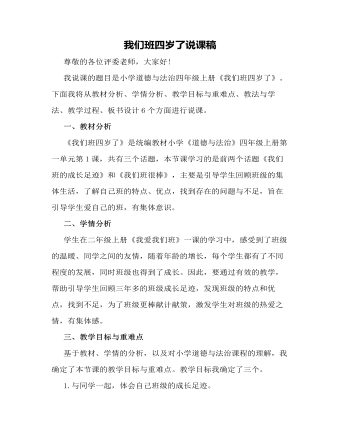
人教部编版道德与法制四年级上册我们班四岁了说课稿
然后,针对这些问题与不足,教师引导学生出主意、想办法,一一找出解决它们的金点子,板贴:金点子设计意图:引导学生找到班级的不足,为了班级更棒献计献策,激发学生对班级的热爱之情,有集体感。环节三:课堂小结,内化提升学生谈一谈学习本节课的收获,教师相机引导。设计意图:梳理总结,体验收获与成功的喜悦,内化提升学生的认识与情感。环节四:布置作业,课外延伸今后的学习生活中,为了自己班越来越棒不断努力。设计意图:将课堂所学延伸到学生的日常生活中,有利于落实行为实践。六、板书设计为了突出重点,让学生整体上感知本节课的主要内容,我将以思维导图的形式设计板书:在黑板中上方的中间位置是课题《我们班四岁了》,下面是:与班级共成长,自己班的优点,自己班的问题与不足,板贴的相应的金点子。
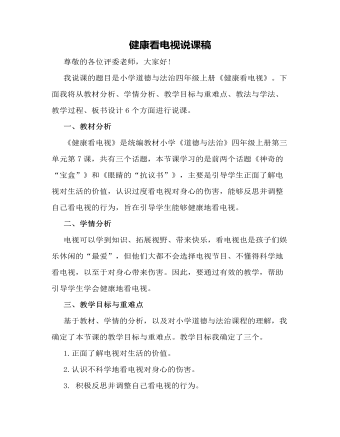
人教部编版道德与法制四年级上册健康看电视说课稿
首先,学生观察板书中学生喜爱看的电视节目,教师引导学生说说哪些节目是适合我们看的。板书:内容健康。然后,教师用多媒体播放医生叔叔对于小学生看电视的忠告,再结合上一个活动看电视对身心的伤害,学生在小组内讨论交流健康看电视的“金点子”,再全班交流,教师引导学生说说生活中怎样做到健康地看电视。板书:保护视力,时间合理等。设计意图:引导学生学会选择电视提供给我们的信息,在讨论交流的过程中,找到健康看电视的一些“金点子”,反思并调整自己看电视的行为。环节三:课堂小结,内化提升学生谈一谈学习本节课的收获,教师相机引导。设计意图:梳理总结,体验收获与成功的喜悦,内化提升学生的认识与情感。环节四:布置作业,课外延伸生活中,做到健康地看电视。设计意图:将课堂所学延伸到学生的日常生活中,有利于落实行为实践。
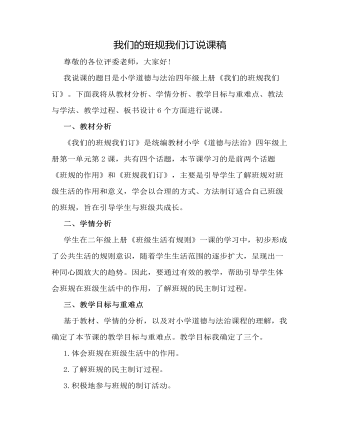
人教部编版道德与法制四年级上册我们的班规我们订说课稿
学生在二年级的时候,就有了制订自己班级规则的体验,在此基础上,学生阅读教材第10页和第11页的图文资料,看看应当怎样制订班规。接着,学生小组合作,找到合理制订班规的程序、方法,再全班汇报交流,教师相机引导。然后,根据本班的具体情况,由教师带领同学们一起讨论,制订适合自己班级的一些班规。板书:自己班的班规。设计意图:引导学生了解合理制订班规的合理方法,并一起制订自己班的班规。环节三:课堂小结,内化提升学生谈一谈学习本节课的收获,教师相机引导。设计意图:梳理总结,体验收获与成功的喜悦,内化提升学生的认识与情感。环节四:布置作业,课外延伸在今后的学习生活中,要自觉遵守自己制订的班规。设计意图:将课堂所学延伸到学生的日常生活中,有利于落实行为实践。
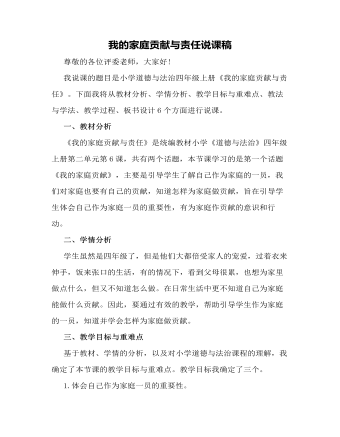
人教部编版道德与法制四年级上册我的家庭贡献与责任说课稿
活动三:用自己的创意和行动为家庭作贡献学生阅读教材第44页,看看图中的创意员为家庭出了哪些“好点子”,再想想自己家是不是也缺少些什么。然后,小组合作出主意,为了让每一个同学家更好,针对缺少的东西,想一些“好点子”。再全班展示交流,教师进行总结评价。板书:自己的创意和行动。设计意图:引导学生在讨论交流的过程中,给家里出一些“好点子”,做一些力所能及的事。环节三:课堂小结,内化提升学生谈一谈学习本节课的收获,教师相机引导。设计意图:梳理总结,体验收获与成功的喜悦,内化提升学生的认识与情感。环节四:布置作业,课外延伸生活中,多为家里做力所能及的事,为家庭做贡献。设计意图:将课堂所学延伸到学生的日常生活中,有利于落实行为实践。
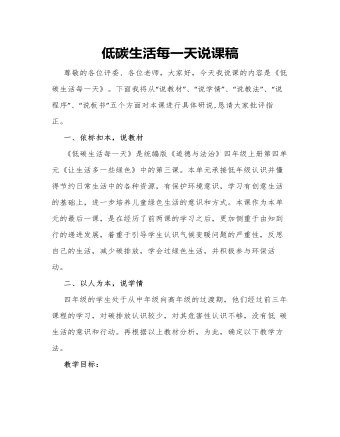
人教部编版道德与法制四年级上册低碳生活每一天说课稿
①看,好几张都是关于汽车尾气的图片。那一辆普通轿车会排放多少温室气体呢?②小结:同学们,现代化的交通工具给我们带来便利的同时,也在大量制造二氧化碳,带来全球变暖,最终给我们人类带来伤害。预设(2):工厂废气小结:工厂生产我们所需物品的同时,也在制造温室气体,使得全球变暖。预设(3):燃烧垃圾、燃烧秸秆预设(4):空调外机等电器①学生介绍②你们想过吗?空调这些家电在投入使用的时候就会间接产生温室气体。③小结:人类的很多活动都在大量排放温室气体,导致全球气候变暖。预设(5):过度砍伐①这张特殊的图片,是谁收集的?你是怎么想的?②小结:大量砍伐森林减少了对温室气体的吸收。我们来看看全球森林面积的现状。③同学们,看了介绍,你最大的感触是什么?3. 小结:“温室气体”排放以及其他人为因素已成为自20 世纪中期以来气候变暖的主要原因。
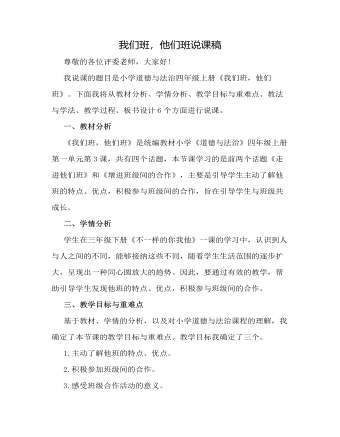
人教部编版道德与法制四年级上册我们班他们班说课稿
在上面两个活动的基础上,教师引导学生交流:你认为开展这类班级合作活动有什么意义?大家可以从中收获什么?板书:与班级共成长。设计意图:引导学生感受并认识班级间合作的意义。环节三:课堂小结,内化提升学生谈一谈学习本节课的收获,教师相机引导。设计意图:梳理总结,体验收获与成功的喜悦,内化提升学生的认识与情感。环节四:布置作业,课外延伸今后的学校生活中,积极地参与班级间的合作。设计意图:将课堂所学延伸到学生的日常生活中,有利于落实行为实践。六、板书设计为了突出重点,让学生整体上感知本节课的主要内容,我将以思维导图的形式设计板书:在黑板中上方的中间位置是课题《我们班,他们班》,下面是:班级的各种特点,积极参与班级间的合作,与班级共成长
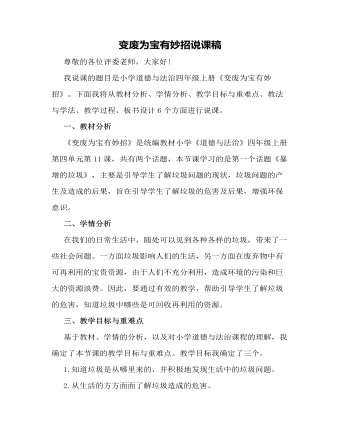
人教部编版道德与法制四年级上册变废为宝有妙招说课稿
一、教材分析《变废为宝有妙招》是统编教材小学《道德与法治》四年级上册第四单元第11课,共有两个话题,本节课学习的是第一个话题《暴增的垃圾》,主要是引导学生了解垃圾问题的现状,垃圾问题的产生及造成的后果,旨在引导学生了解垃圾的危害及后果,增强环保意识。二、学情分析在我们的日常生活中,随处可以见到各种各样的垃圾,带来了一些社会问题。一方面垃圾影响人们的生活,另一方面在废弃物中有可再利用的宝贵资源,由于人们不充分利用,造成环境的污染和巨大的资源浪费。因此,要通过有效的教学,帮助引导学生了解垃圾的危害,知道垃圾中哪些是可回收再利用的资源。三、教学目标与重难点基于教材、学情的分析,以及对小学道德与法治课程的理解,我确定了本节课的教学目标与重难点。教学目标我确定了三个。1.知道垃圾是从哪里来的,并积极地发现生活中的垃圾问题。
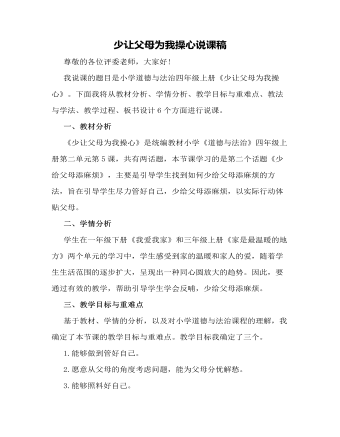
人教部编版道德与法制四年级上册少让父母为我操心说课稿
学生参考教材第31页我们能做得更好的四个方面,结合自己曾经的经验,小组讨论交流,我们尽自己所能,还可以在哪些方面做得更好,让父母少为我们操心,全班汇报交流,教师相机引导,板书:尽自己所能能做得更好的事情。设计意图:引导学生尽自己所能,在生活中做得更好,让父母少为我们操心。环节三:课堂小结,内化提升学生谈一谈学习本节课的收获,教师相机引导。设计意图:梳理总结,体验收获与成功的喜悦,内化提升学生的认识与情感。环节四:布置作业,课外延伸生活中,把能够做得更好的设想变成实际行动。设计意图:将课堂所学延伸到学生的日常生活中,有利于落实行为实践。六、板书设计为了突出重点,让学生整体上感知本节课的主要内容,我将以思维导图的形式设计板书:在黑板中上方的中间位置是课题《少让父母为我们操心》,下面是:管好自己就是为父母分担,多为父母着想,尽自己所能能做得更好的事情。
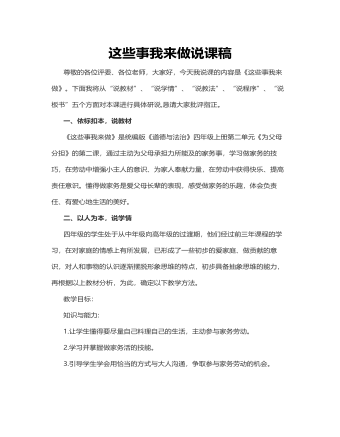
人教部编版道德与法制四年级上册这些事我来做说课稿
(6)教师小结:家务劳动好处多!通过讨论,大家都觉得作为家中的小成员,应为父母分担家务活,应力所能及主动承担家务劳动,老师为你们点赞!设计意图:这篇日记为学生提供了正面典型事例,借助榜样的作用,让学生明白作为家中的小成员,应该主动做些力所能及的家务事,替家长分担。利用教材选取的学生生活画面,针对部分学生不愿意做家务的一些主观原因,引导学生反思自己的生活,辨析他人的观点,旨在让学生理性思考做家务的意义与价值,懂得自己也是家里的小成员,不能只管好自己的事情,也应该合理安排时间为家庭出力,为父母分担,做个愿意主动承担家务劳动的好孩子。(四)、不让做,怎么办1. 组织学生讨论不做家务的其他原因。2. 教师小结:有时候并不是自己不愿意做家务,而是大人不让做。下节课的学习将一起讨论面对这样的情况该怎么办。
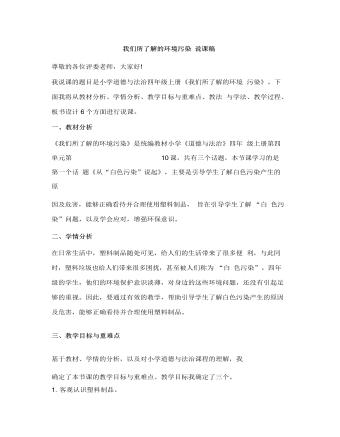
人教部编版道德与法制四年级上册我们所了解的环境污染说课稿
首先,学生阅读教材第74 页,教师引导学生交流:塑料垃圾危害这么大,我们能完全不使用塑料制品吗?如果完全不使用塑料制品, 我们的生活会变成怎样呢?生活中我们离不开塑料制品,那要怎样合 理使用呢?板书: 减少塑料袋的使用量,尽量使用塑料制品的替代品。然后, 结合课前调查和收集到的有关塑料制品的替代品,先小组讨论交流:在生活中有哪些塑料制品的替代品呢?再全班汇报交流, 教师相机引导。设计意图:引导学生了解生活离不开塑料制品,但要合理使用, 减少塑料袋的使用量,尽量使用塑料制品的替代品。环节三:课堂小结,内化提升 学生谈一谈学习本节课的收获,教师相机引导。 设计意图:梳理总结,体验收获与成功的喜悦,内化提升学生的认识与情感。

人教部编版道德与法制四年级上册正确认识广告说课稿
一、依标扣本,说教材本课是统编版教材《道德与法治》四年级上册第三单元《信息万花筒》的第三课。《信息万花筒》是信息技术主题,本单元涉及的电视、网络、广告都是四年级学生感兴趣的话题。本课重点是通过正确认识生活中无处不在的广告,了解广告并不都是可信的,学会识别广告,做聪明、理性的消费者。本课共三个话题话题一“无处不在的广告”,引导学生感受在我们的生活中,广告无处不在。话题二“广告都可信吗”,引导学生通过生活经验的回顾,了解到广告并非都是可信的,存在虚假广告。话题三“学会识别广告”,引导学生了解广告的一些常用的“招数”,能够正确识别广告,学会破解广告招数、抵御广告诱惑的方法。二、以人为本,说学情四年级的学生处于从中年级向高年级的过渡期,他们经过前三年课程的学习,对网络等新媒介接受较快、依赖度高,再加上自制力虽形成但不持久,对人和事物的认识逐渐摆脱形象思维的特点,初步具备抽象思维的能力。
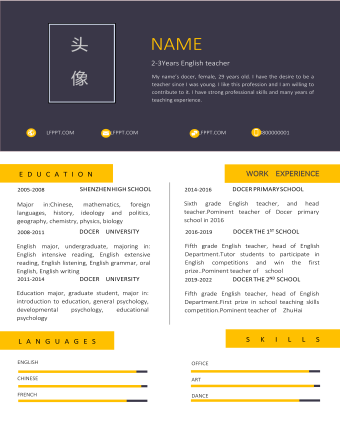
蓝黄色英语教师英文简历
Major in:Chinese, mathematics,foreign languages, history, ideology and politics, geography, chemistry,physics, biologyEnglishmajor, undergraduate, majoring in: English intensive reading, English extensivereading, English listening, English grammar, oral English, English writingEducationmajor, graduate student, major in: introduction to education, generalpsychology, developmental psychology, educational psychology
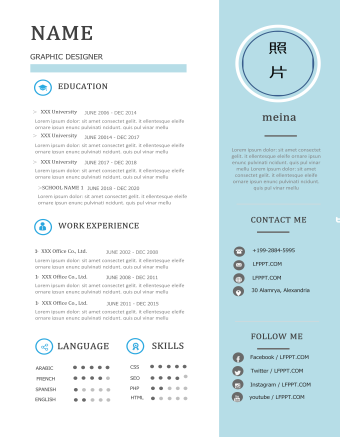
清新英文简历模板
Lorem ipsum dolor: sit ametconsectet gelit. it ellentesque eleife ornare ipsun enunc pulvinati ncidunt.quis pul vinar mellu Lorem ipsum dolor: sit amet consectet gelit. itellentesque eleife ornare ipsun enunc pulvinati ncidunt. quis pul vinar mellu。Loremipsum dolor: sit amet consectet gelit. it ellentesque eleife ornare ipsun enuncpulvinati ncidunt. quis pul vinar mellu.
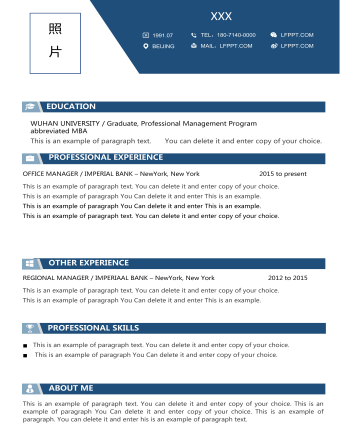
个人求职英文简历模板
OFFICE MANAGER / IMPERIAL BANK – NewYork, NewYork 2015 to presentThis is an example of paragraph text. You can delete it and enter copyof your choice. This is an example of paragraph You Can delete it and enter This is anexample. This is anexample of paragraph You Can delete it and enter This is an example. This is anexample of paragraph text. You can delete it and enter copy of your choice.